Struggling with an extruder motor not turning? Explore our detailed guide for troubleshooting and resolving common motor issues in single-screw extruders.
In the world of plastic manufacturing, the single-screw extruder stands as a pivotal component, primarily used for extruding various thermoplastic materials like soft and hard PVC, and PE. These machines are capable of processing a myriad of plastic products, ranging from film blowing and pipe extrusion to sheet pressing and filament drawing, also extending to melt granulation. Originally utilizing DC motors known for their low-speed and high-torque characteristics, these extruders have evolved due to safety concerns in dusty environments, where sparks from carbon brushes were a hazard. Nowadays, three-phase asynchronous motors are standard, with servo motors employed for specific, specialized applications.

Why Your Extruder Motor Might Not Be Working
The central issue we often encounter in single-screw extruders is the extruder motor not turning. This issue can be caused by:
- Incorrect Startup Procedure: Ensuring the right startup sequence is crucial. A misstep here can prevent the motor from operating.
- Interlocks Related to the Main Motor: These safety features can inadvertently stop the motor if not properly managed.
- Wiring Issues and Fuse Problems: Any fault in the electrical system can halt operations.
Troubleshooting Steps
To address a non-functional extruder motor:
- Review the Startup Procedure: Double-check and follow the correct steps to initiate operations.
- Inspect the Electrical Circuitry: Ensure the wiring and connections are intact and functioning.
- Check the Lubrication Pump and Interlocks: Confirm the pump’s operation and the status of related interlocks. A non-operational pump can lead to motor issues.
- Frequency Converter Issues: Wait for residual electricity to dissipate by shutting down the power for 5 minutes before restarting.
- Reset Emergency Buttons: Ensure all emergency systems are reset and not hindering the motor.
Dealing with Unstable Main Motor Current
In cases where the motor current is unstable, consider:
- Uneven Feeding: Check the feeding mechanism for consistency.
- Motor Bearing Damage or Lubrication Issues: Inspect and possibly replace bearings, and ensure proper lubrication.
- Heater Malfunction: Verify each segment of the heater is operational.
- Screw Adjustment and Component Interference: Ensure correct screw placement and no internal obstructions.
High Starting Current in the Main Motor
This issue typically stems from insufficient heating or a non-operational heating segment. Extend the heating time or check each heater’s functionality.
Unusual Motor Noise
Damaged bearings or issues in the thyristor rectifier circuit of the motor can cause this. Replace bearings or rectifier components as needed.
Conclusion
Resolving issues like the extruder motor not turning requires a methodical approach, encompassing a thorough understanding of the equipment and a keen eye for detail. Regular maintenance and awareness of potential issues can prevent most problems, ensuring your single-screw extruder operates smoothly and efficiently.
Tags:
Extrusion Process (1) PA Extrusion (1) Plastic Extruders (3) Reinforced Hose (2) Success Projects (1) TPE Extrusion (1) Troubleshooting (1)



